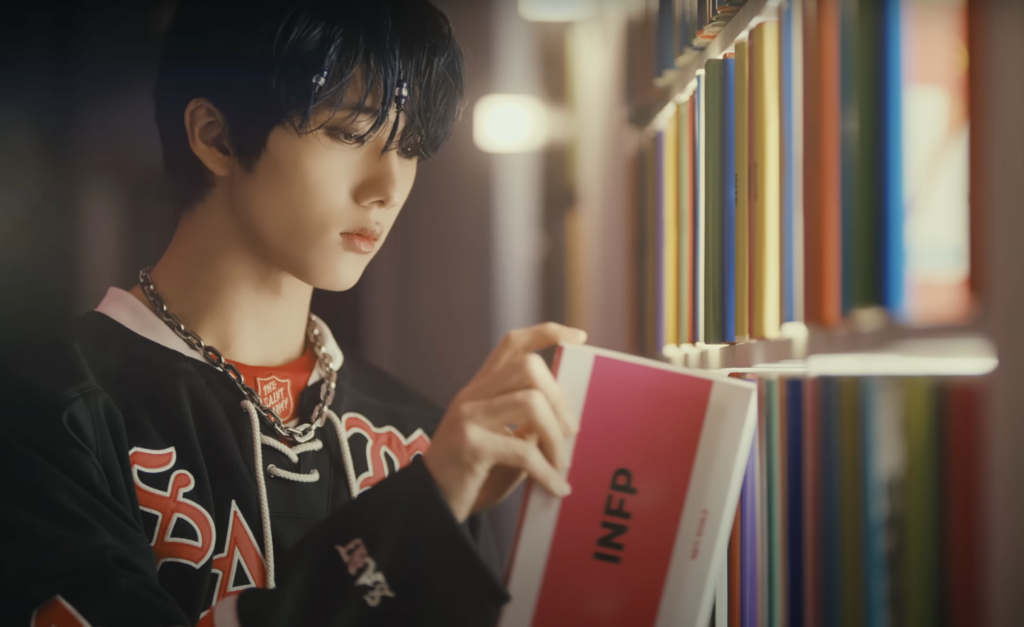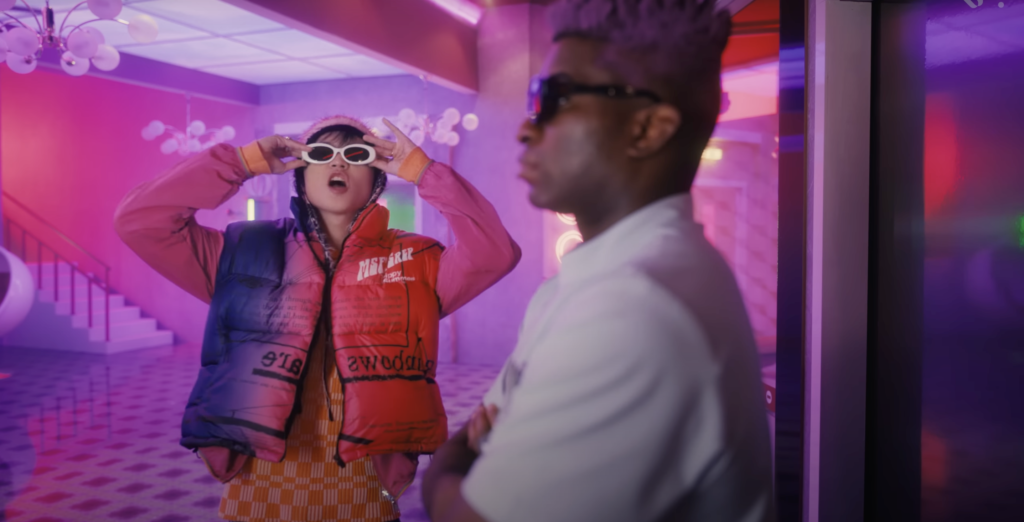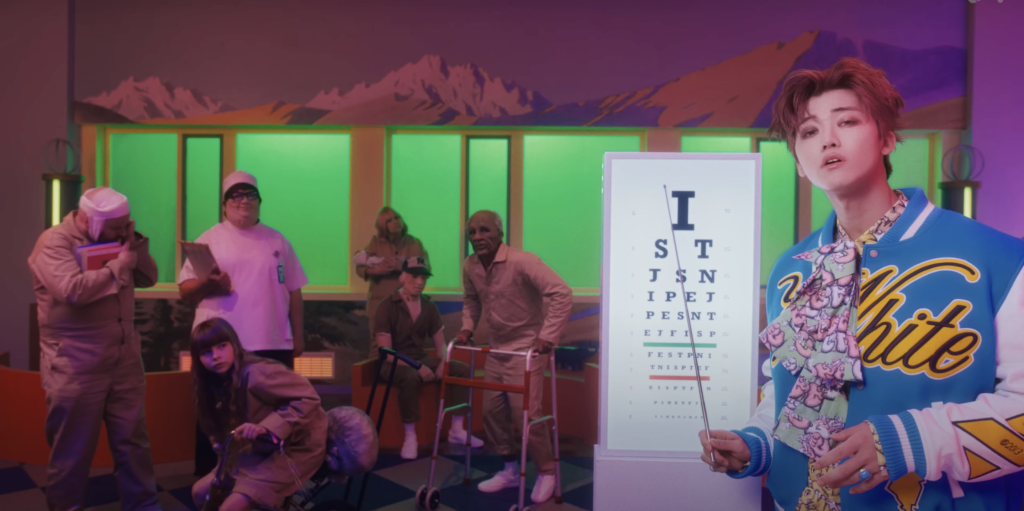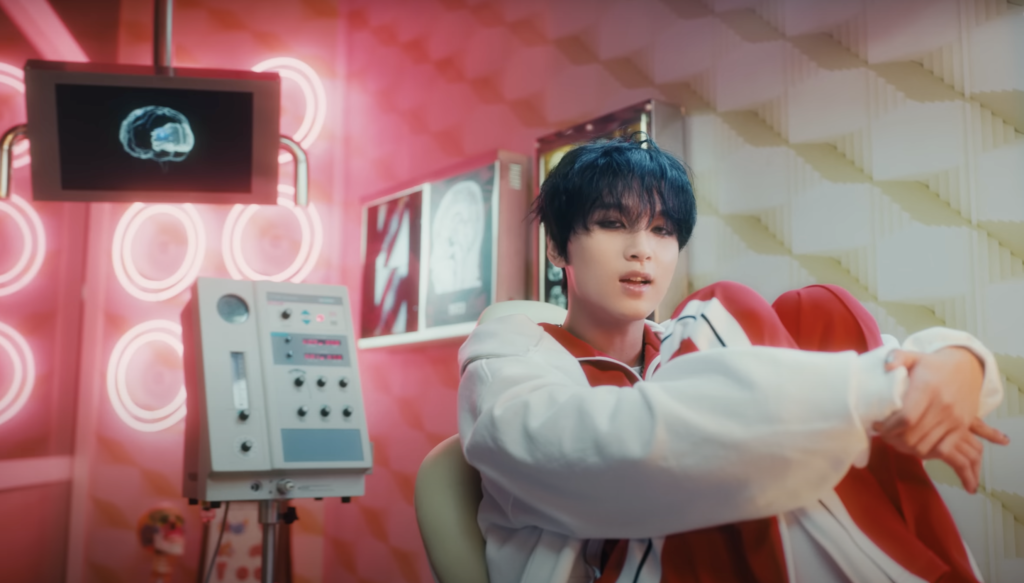
The Myers-Briggs Type Indicator (MBTI) personality test has been a major trend in Korea over the past few years – it is not uncommon for idols to share their types, or even take MBTI assessments on air. It was only a matter of time before a group would take on this subject matter, as NCT Dream do in their new title track, “ISTJ,” from their album of the same name. Mark explained in a press conference that the group portray an ENFP persona in love with an ISTJ persona, which represents NCTzens. The ISTJ personality type, which stands for Introverted – Sensing – Thinking – Judging, is said to be dependable, systematic, and traditional. None of those defining characteristics, however, are reflected in the “ISTJ” MV, which is a frenzied sensory overload, muddling the storyline it intends to depict.
A teaser video, entitled “ISTJ <-> ENFP”, starred the members playing one of those two types. Mimicking a documentary and evoking a 70s graphic aesthetic, the teaser video parodied these two opposing archetypes. As extroverted characters who are supposed to be energetic, spontaneous, and even quirky, Haechan, Jisung, Chenle, and Renjun wear brightly colored outfits with mismatched prints. Meanwhile, Mark, Jeno, and Jaemin play introverted characters in conservative, neutral-colored suits who make minimal body movements – as Mark explains, “Simple is the best.”
The actual “ISTJ” MV, however, is not interested in such visual simplicity, and is consistently vibrant and dynamic, starting with the console of a vehicle reading “Departure – Real World” and “Arrival MBTI World.” An ambulance goes hurtling through a thunderous sky, recalling time travel in Back to the Future. The camera takes the point of view of the ambulance, speeding through a hole and over a hedge maze, and careening through a doorway in the shape of a clown’s head. That image suggests we, along with the members of NCT Dream, are entering a funhouse. Once Mark kicks a door open to begin the first verse, we are bombarded with kaleidoscopic color and propulsive beats. Wearing bold prints and multi-colored jackets, the NCT Dream members all recall the costuming of ENFPs from the teaser.

For a song entitled “ISTJ,” there is not much direct representation of that type. No central human figure represents the ISTJ love interest. Instead, a bodyguard looms in front of metallic doors, over which an “EXIT” sign morphs to read “ISTJ.” In MBTI World, the ISTJ figure is a physical space that the members wish to access, especially because they think there may be more complexity behind the facade of flawlessness:
You seem perfect but
Inside your emotions
Stacked into layers
I want to get in
And mess them up a little
Rather than directly depicting the idea of a person getting to know the layers of another person with a seemingly opposite personality, the “ISTJ” MV focuses on disrupting the notion of personality types altogether. The MV attempts this through its semblance of a plot: the members have entered the MBTI World hospital, where patients dressed in tan uniforms don bracelets with their MBTI types and form a single-file line to check out VHS tapes, also labeled with MBTI. One shot, apparently from the view of a surveillance camera, displays people’s MBTIs over their figures.

To an extent, the narrative of the MV aligns with the song’s themes of breaking through personality stereotypes. As Haechan declares in the first verse, “I’m reading through You-Ology,” rather than established, reductive systems of determining personality. NCT Dream are not there to be categorized and labeled, and they want to “mess up” this system. Jisung hits an alarm, and Jeno knocks over tapes on a counter, but quickly hospital attendants drag Jaemin and Mark away. Later, however, it is revealed that the members have duct taped the mouth of one of the doctors.
There is also the suggestion that some of the hospital staff resist the rigidity of MBTI World themselves. A doctor shows Haechan X-rays of various brains, each labeled by type, but then there is a shot later on of a brain scan with dots indicating multiple personality types. The aforementioned doctor also reveals a VHS case called “The Great Escape,” with a cassette labeled “Exit,” enabling NCT Dream with a means to break free. Another person working in the hospital pulls a plug, presumably of surveillance cameras around the premises. Thus, the Dream members are able to run through the hedge maze towards an exit, dance in front of the MBTI World facade with fireworks set off in the background, and use the “Exit” tape to transport back to the real world.

Perhaps aside from some establishing shots at the beginning, we never see the real world. “ISTJ” sets up dualities (real world and MBTI world, ISTJ and ENFP, hospital patients and NCT Dream), but doesn’t render them visually, at least not fully. There is some established contrast in costuming and energy between the bold Dream members and drab patients, but the MV’s quick cuts and tracking camera make it difficult to register these differences. The message of the ISTJ-ENFP connection across differences becomes muddled without more aesthetic variation.
With its tempo changes in the pre-chorus and the R&B-based bridge, “ISTJ” actually presents opportunities for the visual elements to also slow down and shift. While the camera work seems slightly less frenetic in these moments, there are still constant tracking and zooming movements all throughout the MV. The production design doesn’t change either, with its oversaturated colors in every set.
More contrast could have potentially highlighted the switch-ups in the song and reinforced the message of the MBTI concept. The “ISTJ” MV is a playful, kinetic, wild ride, but aesthetically, it lacks some of the complexity that “ISTJ” has in its song structure, and advocates for in its lyrics.
(YouTube[1][2][3]. Lyrics via Genius. Images via SM Entertainment.)
0 Comments